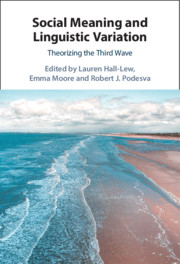Book contents
- Social Meaning and Linguistic Variation
- Social Meaning and Linguistic Variation
- Copyright page
- Contents
- Acknowledgments
- Figures
- Tables
- Contributors
- 1 Social Meaning and Linguistic Variation: Theoretical Foundations
- Part I Where Is (Social) Meaning?
- Part II The Structure of Social Meaning
- 7 Sociolinguistic Signs as Cognitive Representations
- 8 Perceptions of Style: A Focus on Fundamental Frequency and Perceived Social Characteristics
- 9 Features, Meanings, and Indexical Fields
- 10 Reconciling Seemingly Conflicting Social Meanings
- 11 Biographical Indexicality: Personal History as a Frame of Reference for Social Meaning in Variation
- Part III Meaning and Linguistic Change
- Index
- References
7 - Sociolinguistic Signs as Cognitive Representations
from Part II - The Structure of Social Meaning
Published online by Cambridge University Press: 30 July 2021
- Social Meaning and Linguistic Variation
- Social Meaning and Linguistic Variation
- Copyright page
- Contents
- Acknowledgments
- Figures
- Tables
- Contributors
- 1 Social Meaning and Linguistic Variation: Theoretical Foundations
- Part I Where Is (Social) Meaning?
- Part II The Structure of Social Meaning
- 7 Sociolinguistic Signs as Cognitive Representations
- 8 Perceptions of Style: A Focus on Fundamental Frequency and Perceived Social Characteristics
- 9 Features, Meanings, and Indexical Fields
- 10 Reconciling Seemingly Conflicting Social Meanings
- 11 Biographical Indexicality: Personal History as a Frame of Reference for Social Meaning in Variation
- Part III Meaning and Linguistic Change
- Index
- References
Summary
The third-wave approach treats linguistic variation as a semiotic system, with linguistic forms serving as components of sociolinguistic signs. In Peirce’s semiotic, a critical part of the sign is the interpretant, crucial to theories of indexicality that no sign exists independently of its construal. This chapter explores framing the interpretant as the cognitive processes involved in a listener’s recognition of a form-meaning link, and as the resulting mental representation of that link. A recognition memory paradigm tested the association between a Business Professional persona and backed TRAP vowels. Some participants were told the speaker was a BP and some were told nothing. Some listeners heard a linguistic variant congruent with the persona (backed TRAP), while others heard an incongruent variant (fronted TRAP). Listeners accurately remembered a word better when persona and linguistic feature were congruent, and were also more likely to falsely remember sociolinguistically congruent words. This suggests that a speaker’s social persona shapes how we remember – and mis-remember – a feature of that speaker’s linguistic style in ways that conform to our ideological expectations.
- Type
- Chapter
- Information
- Social Meaning and Linguistic VariationTheorizing the Third Wave, pp. 153 - 175Publisher: Cambridge University PressPrint publication year: 2021
References
- 3
- Cited by



